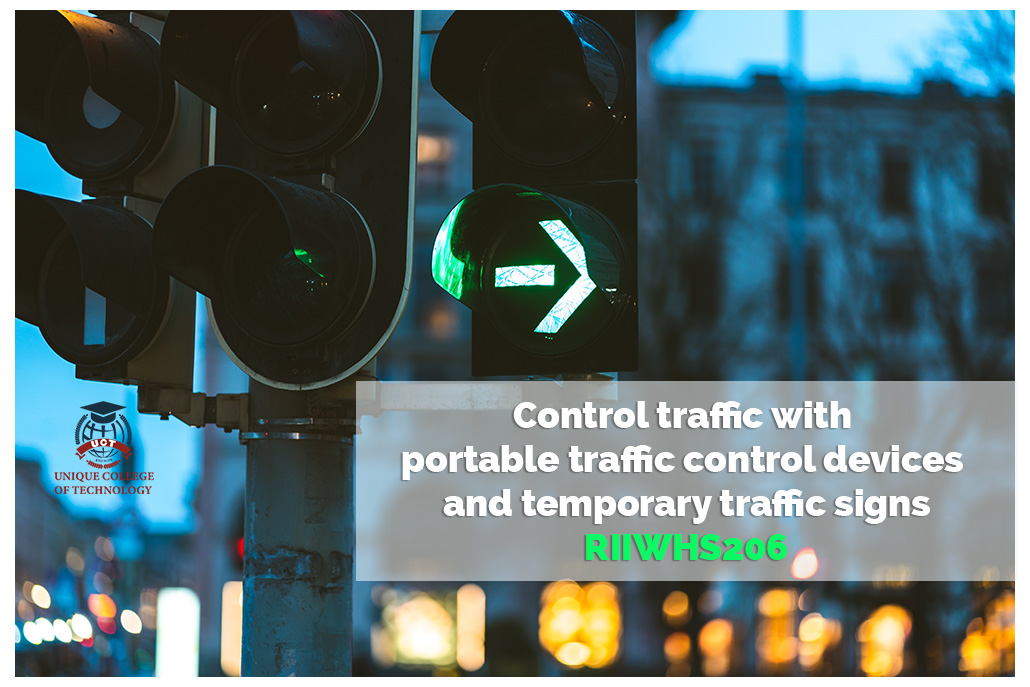
Modification History
Not applicable.
Application
This unit describes the skills and knowledge required to monitor and control traffic with portable traffic control devices and temporary traffic signs according to traffic management plans and traffic guidance schemes.
It applies to those working in operational roles. They generally work in teams in live traffic environments under some degree of supervision.
No licensing, legislative or certification requirements apply to this unit at the time of publication.
Unit Sector
Civil construction
Elements and Performance Criteria for Control traffic with portable traffic control devices and temporary traffic signs
|
ELEMENT |
PERFORMANCE CRITERIA |
|
Elements describe the essential outcomes. |
Performance criteria describe the performance needed to demonstrate achievement of the element. |
|
1. Prepare to control traffic |
1.1 Select and wear personal protective equipment required for work activities 1.2 Identify and confirm work activities and traffic conditions 1.2 Perform site specific risk assessments 1.3 Select tools and equipment, check for serviceability, and rectify faults and report according to workplace policies and procedures |
|
2. Control traffic |
2.1 Position and confirm portable traffic control devices and temporary traffic signs according to traffic guidance scheme 2.2 Confirm safe location of traffic controllers when operating portable traffic control devices 2.3 Monitor traffic flow and confirm portable traffic control devices are performing according to job requirements 2.4 Monitor traffic flow and confirm temporary traffic signs are placed according to job requirements |
|
3. Conduct housekeeping activities |
3.1 Confirm portable traffic control devices and temporary traffic signs are removed according to traffic guidance scheme 3.2 Confirm portable traffic control devices, temporary traffic signs, tools and equipment are cleaned, checked, maintained and stored according to workplace policies and procedures |
Foundation Skills for Control traffic with portable traffic control devices and temporary traffic signs
This section describes those language, literacy, numeracy and employment skills that are essential to performance but not explicit in the performance criteria.
|
Skill |
Description |
|
Numeracy |
|
|
Oral communication |
|
|
Reading |
|
|
Technology |
|
Unit Mapping Information
New unit
Links
Companion Volume implementation guides are found in VETNet – https://vetnet.gov.au/Pages/TrainingDocs.aspx?q=88a61002-9a21-4386-aaf8-69c76e675272
Assessment requirements
Modification History
Not applicable.
Performance Evidence for Control traffic with portable traffic control devices and temporary traffic signs
The candidate must demonstrate the ability to complete the tasks outlined in the elements, performance criteria and foundation skills of this unit, including evidence of the ability to:
- control traffic with portable traffic control devices and temporary traffic signs according to traffic guidance schemes in a manner that is safe and follows workplace policies and procedures on at least two occasions.
During the above, the candidate must:
- manually handle required tools
- identify and implement site specific requirements
- identify type, scope and potential impact of hazards
- identify and apply environmental protection requirements
- identify and apply risk control measures
- complete housekeeping requirements.
Knowledge Evidence for Control traffic with portable traffic control devices and temporary traffic signs
The candidate must be able to demonstrate knowledge to complete the tasks outlined in the elements, performance criteria and foundation skills of this unit, including knowledge of:
- documentation types required to confirm work activity is compliant, including:
- traffic management plans
- traffic guidance schemes
- work instructions
- legislative requirements
- safety requirements
- environmental protection requirements
- emergency procedures
- portable traffic control devices documentation
- required site conditions and work types undertaken
- traffic management risk management processes and hierarchy of control, including risk assessment procedures
- equipment, signs and devices compliant with traffic management plans and traffic guidance schemes
- principles for determining safe locations for traffic controllers to operate portable traffic control devices and temporary traffic signs
- traffic flow principles and the interaction between road users and portable traffic control devices and temporary traffic signs, including:
- the impact of signal sequence on traffic flow
- factors that cause portable traffic control devices to impede traffic flow
- traffic flow principles and the interaction between all road users and portable traffic control devices and temporary traffic signs, including:
- the impact of signal sequence on traffic flow
- factors that cause portable traffic control devices to impede traffic flow.
Assessment Conditions
Mandatory conditions for assessment of this unit are stipulated below. The assessment must:
- include access to:
- traffic management plan
- traffic guidance scheme
- portable traffic control devices
- temporary traffic signs
- personal protective equipment
- be conducted in a safe environment; and,
- be assessed in the context of this sector’s work environment on a real live road setting under supervision; and,
- be assessed in compliance with relevant legislation/regulation and using policies, procedures and processes directly related to the industry sector for which it is being assessed; and,
- confirm consistent performance can be applied in a range of relevant workplace circumstances.
Where personal safety or environmental damage are limiting factors, assessment may occur in a simulated work environment* provided it is realistic and sufficiently rigorous to cover all aspects of this sector’s workplace performance, including environment, task skills, task management skills, contingency management skills and job role environment skills.
Assessor Requirements
Assessors must be able to clearly demonstrate current and relevant industry knowledge and experience to satisfy the mandatory regulatory standards as set out in the Standards for Registered Training Organisations (RTOs) 2015/Australian Quality Training Framework mandatory requirements for assessors current at the time of assessment and any relevant licensing and certification requirements. This includes:
- vocational competencies at least to the level being delivered and assessed
- current industry skills directly relevant to the training and assessment being provided
- current knowledge and skills in vocational training and learning that informs their training and assessment
- formal relevant qualifications in training and assessment
- having knowledge of and/or experience using the latest techniques and processes
- possessing the required level of RII training product knowledge
- having an understanding and knowledge of legislation and regulations relevant to the industry and to employment and workplaces
- demonstrating the performance evidence, and knowledge evidence outlined in this unit of competency, and
- the minimum years of current** work experience after competency has been obtained as specified below in an industry sector relevant to the outcomes of the unit.
It is also acceptable for the appropriately qualified assessor to work with an industry expert to conduct assessment together and for the industry expert to be involved in the assessment judgement. The industry expert must have current industry skills directly relevant to the training and assessment being provided. This means the industry subject matter expert must demonstrate skills and knowledge from the minimum years of current work experience after competency has been obtained as specified below, including time spent in roles related to the unit being assessed:
Industry sector |
AQF indicator level*** |
Required assessor or industry subject matter expert experience |
|
Drilling, Metalliferous Mining, Coal Mining, Extractive (Quarrying) and Civil Infrastructure |
1 |
1 year |
|
2 |
2 years |
|
|
Drilling, Coal Mining, Extractive (Quarrying), Metalliferous Mining and Civil Infrastructure |
3-6 |
3 years |
|
Other sectors |
Where this unit is being assessed outside of the resources and infrastructure sectors assessor and/or industry subject matter expert experience should be in-line with industry standards for the sector in which it is being assessed and where no industry standard is specified should comply with any relevant regulation. |
|
*Guidance on simulated environments has been stipulated in the RII Companion Volume Implementation Guide located on VETNet.
**Assessors can demonstrate current work experience through employment within industry in a role relevant to the outcomes of the unit; or, for external assessors this can be demonstrated through exposure to industry by conducting a minimum number of site assessments as determined by the relevant industry sector, across various locations.
*** While a unit of competency does not have an AQF level, where a unit is being delivered outside of a qualification the first numeric character in the unit code should be considered as the AQF indicator level for assessment purposes.

